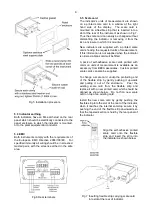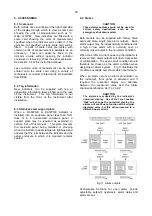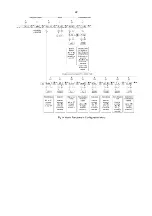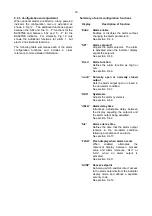
21
9.4.1 Solid state output
Each alarm output is a galvanically isolated single
pole solid state switch as shown in Fig 12. The
output is polarised and current will only flow in one
direction, terminals 8 and 10 should therefore be
connected to the positive side of the circuit being
switched.
Ron
=
less than 5
Ω
+ 0.7V
Roff
=
greater than 1M
Ω
Fig 12 Equivalent circuit of each alarm output
9.4.2 Type nA certification
Each alarm output is a separate galvanically
isolated Ex nA circuit with the following input
parameters:
Ui
=
30V dc
Ii
=
200mA
This allows each alarm output to switch any dc
circuit providing that in normal operation the
maximum supply voltage is not greater than 30V
dc and the switched current is not greater than
200mA.
Providing that the BA307NE or BA327NE indicator
is correctly installed in a panel enclosure located in
Zone 2 complying with the requirements for Ex n
protection, the two alarm outputs may be used to
switch suitably protected equipment located in any
Zone of a hazardous area, or equipment located in
a safe area..
Fig 13 shows a typical application in which a
BA307NE or BA327NE indicator mounted in an
Ex n panel enclosure located in Zone 2 is
displaying the output from an Flameproof Ex d
2-wire transmitter located in Zone 1. Alarm 1 is
switching an Ex e sounder in Zone 1 and alarm 2 is
switching a sounder located in the safe area.
Fig 13 Typical alarm application
(Shown without recommended screened cables)
To comply with the requirements of
BS EN 60079-14
Electrical installations design,
selection and erection
, each of the wires entering
the hazardous area should be individually fused
and contain a means of isolation. These two
requirements are frequently satisfied by using fuse
holders with easily removable fuses and removing
the fuses to achieve isolation. This is a
satisfactory method at the low voltages and
currents common in instrumentation systems.
Clear identification of, and easy access to the
means of isolation is essential for their effective
use. It is also necessary to ensure that the
maintenance procedure makes sure that
unauthorised re-closure of the switches does not
occur. It is not considered necessary to have a
means of isolation or electrical protection for the
screen. Figure 20 illustrates an example of this
type of switch fuse terminal block.
For some application Ex nA instrumentation
energised by a current limited power supply or
instrument that can be switched off, is often
considered adequate and to comply with the
requirements of the standard.











































